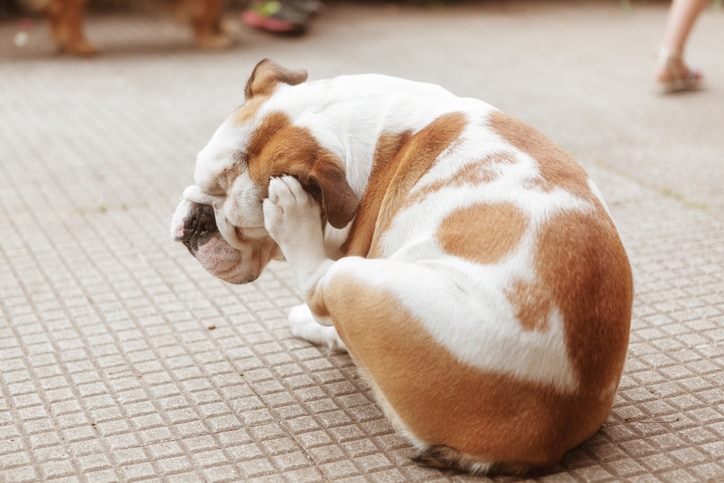Hotspots on dogs are a common skin ailment you’ve probably seen but don’t know about. Hotspots typically appear as moist, oozing, reddened areas of any shape. These sores are often quite painful and itchy.
>> Searching for a dog sitter? Find one in your area now.
What causes hotspots?
Hotspots on dogs are caused when a dog chews or irritates broken skin, introducing bacteria that can cause a mild to moderate infection. “Hotspots are an infection of the superficial layer of the skin,” says veterinarian Dr. Jessica Vogelsang. “Dogs cause them by biting or licking their skin and breaching its natural defenses, allowing the bacteria normally present on the surface of the skin to invade.”
Excess licking and chewing causes the infection to spread and worsen, starting a painful cycle for your dog. “Hotspots typically start with a localised area of itching and irritation. Often this happens due to a flea or other insect bite, but it can also be caused by contact allergies from grass or other substances,” says veterinarian Dr. Chris Bern of A Vet’s Guide to Life.
“An area of the skin becomes inflamed and very itchy. This skin irritation leads to the dog scratching or chewing at the area, breaking the skin and leading to secondary skin infections. The infection and additional irritation leads to further itchiness, and therefore more intense chewing, and a larger area is created in a self-perpetuating cycle.”
Though most mild hotspots can be treated at home, it’s important to go to the vet if you don’t see improvement or if your dog has a fever or acts lethargic. You should see a doctor “if there is bleeding, pus or excessive moisture [or] if the symptoms don’t improve within a day or two,” advises Dr. Bern. “Anything more than a small area of reddened skin should be looked at.” To help prevent hotspots, keep your dog well-groomed and help it avoid stress and fleas, says the ASPCA.
How to treat
Though home remedies aren’t always the best solution, if you notice a small or mild hotspot, a home remedy could provide some quick relief. However, before applying anything to the hotspot, it’s important to prepare the affected area. Brandy Arnold, editor of The Dogington Post, says, “Hotspots almost always result in hair loss in the affected area, and any fur that remains on or around the hotspot should be clipped.”
If you catch them early, there are several natural ways to treat hotspots on dogs at home, without the use of prescription medications. Here are a few home remedies to try:
1. Wash with soap
The most common home treatment involves using antibacterial soap on the wound and washing it once daily. This method is most effective on small or mild hotspots, and pet owners should expect to see an improvement in three to five days.
2. Steep tea
About Puppies recommends steeping a tea bag in hot water, cooling it thoroughly, and then placing it against the hotspot. This can be repeated several times a day.
3. Apply herbal remedies
Homeopathic expert Dana Scott of Dogs Naturally Magazine recommends remedies such as “belladonna, graphites, mercurius and rhus tox.” “You could also spray calendula tincture on the hotspot,” she says. “I’ve found these remedies to be so effective that shaving is rarely necessary.”
4. Run a bath
Dr. Bern recommends oatmeal baths. “They can be very soothing to the skin and are a good treatment for mild cases,” he says.
5. Break into the medicine cabinet
To help keep dogs from licking or otherwise continuing to agitate the hotspot, put a small amount of vaporising rub around the affected area. To relieve itching, a small amount of witch hazel spray is a topical option.
Chances are good dog sitters will encounter a dog with hotspots at some point. Make sure the caretaker knows about special care tricks and any medicine or remedies you use. Let him or her know what steps you’re taking to prevent the dog from licking or biting the hotspot. Trainers or sitters should let you know about hotspots that come up and be prepared to make a vet appointment if the hotspots become serious.
By freelance writer Amanda Kondolojy
